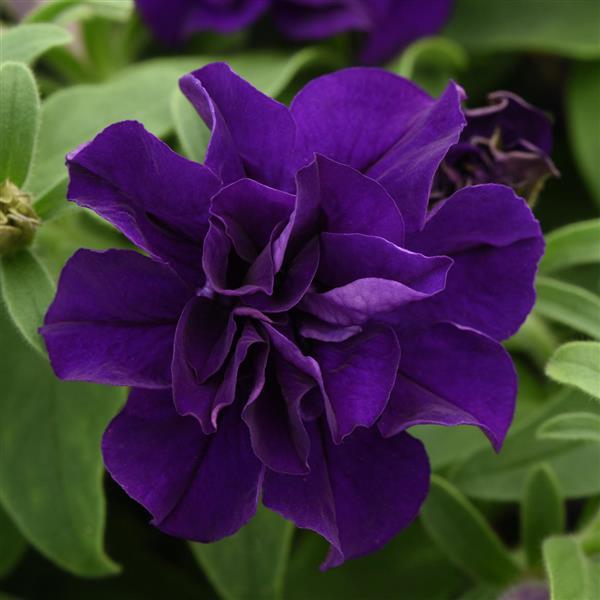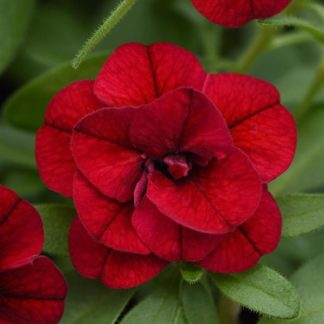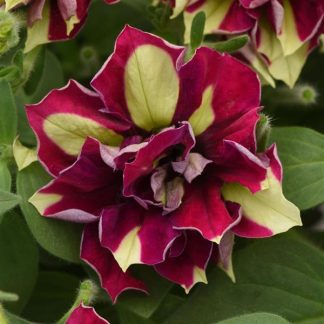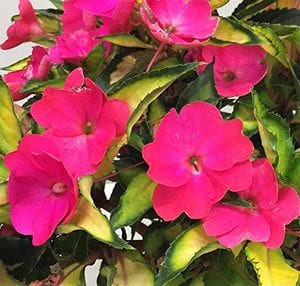Description
Petunia ‘Double Vogue Blue’: A Ruffled Symphony in Rich Sapphire
Meet ‘Double Vogue Blue’
Step onto the porch on a warm May morning, and picture a basket overflowing with plush, blue-violet rosettes. Each bloom looks like a tiny ball gown, layered in waves and trimmed with soft ruffles. That is the magic of Petunia ‘Double Vogue Blue’. This modern hybrid works as hard as it dazzles, blooming from late spring until the first autumn frost. Best of all, it does so with very little fuss. In other words, you gain months of bold color without months of extra chores.
Why We Love Its Deep-Blue Double Blooms
Blue is rare in the flower world, and true blue is even rarer. Yet ‘Double Vogue Blue’ pushes the palette toward pure sapphire. Each blossom is fully double, meaning many petals form a full rosette about the size of a silver dollar. The petals hold their color through summer’s heat instead of fading to gray. Hummingbirds hover for a sip. Butterflies drift in to rest. Neighbors stop and ask, “What is that gorgeous plant?”
But most of all, we love how this petunia fills space. The plant mounds to around eight or nine inches, then trails out to nearly two feet. It drapes over pots, softens garden edges, and hides the gap between tall uprights and low groundcovers.
Botanical Snapshot
- Botanical Name: Petunia ‘Double Vogue Blue’
- Family: Solanaceae (nightshade family, alongside tomatoes and peppers)
- Plant Type: Tender perennial grown as an annual in most regions
- Habit: Vigorous, mounding then gently trailing
- Mature Height: 8–10 inches (20–25 cm)
- Spread: 14–24 inches (35–60 cm)
- Bloom Size: 1.5–2 inches across, fully double
- Bloom Time: Late spring to frost
- Color Palette: Rich blue to deep violet, sometimes with a faint lavender sheen
- Fragrance: Light, sweet, most noticeable in the evening
- Pollinator Appeal: Hummingbirds, butterflies, and friendly bees
Perfect Places to Plant
You do not need a huge garden to enjoy ‘Double Vogue Blue’. All it asks for is at least six hours of sun and soil that drains well. Here are favorite spots:
- Hanging Baskets – The trailing stems spill like a velvet waterfall. Hang one by the front door for instant curb appeal.
- Window Boxes – Let the blue blooms frame your panes and link indoor living to the garden outside.
- Patio Containers – Pair with white angelonia and lime coleus for a bright, cool combo.
- Garden Edges – Use in the front of a mixed border; the soft mounds blur hard lines.
- Raised Veggie Beds – Tuck a few starts along the edge. They attract pollinators and add color between greens.
Design Ideas and Companions
- Cool Classic: Team ‘Double Vogue Blue’ with silver artemisia and white bacopa. The silver foliage makes the blue glow.
- Sunset Contrast: Surround it with orange calibrachoa for a lively, opposite-wheel pop.
- Moonlight Basket: Add soft yellow calibrachoa and trailing dichondra for an evening patio that shines under café lights.
- Cottage Path: Mix with pink geraniums, lavender, and a sprinkle of baby’s breath for waves of texture.
- Pollinator Patch: Combine with scarlet salvia and tall verbena to create layers of nectar from ground to sky.
How to Care for ‘Double Vogue Blue’
Light and Temperature
‘Double Vogue Blue’ loves the sun. Aim for at least six hours of direct light. In very hot southern gardens, a dash of afternoon shade keeps blooms fresh. Nighttime temps of 55–65 °F (13–18 °C) help flowers deepen in color, while daytime highs up to 90 °F (32 °C) are tolerated if roots stay moist.
Soil and Potting Mix
Good drainage is key. In beds, enrich native soil with two inches of compost to boost air pockets and food. For containers, choose a peat-free or peat-light potting mix labeled for annuals. A pH between 6.0 and 7.0 keeps nutrients available.
Water Needs
Think “evenly moist” rather than soggy. Stick a finger one inch into the soil. If it feels dry, water until moisture flows from the pot’s drain holes or until garden soil feels damp to that depth. In hanging baskets under full sun, daily watering may be needed in July and August.
Feeding for Flower Power
Blooming nonstop takes fuel. Start with a slow-release, balanced fertilizer mixed into soil at planting. Then, every week or two, water with a liquid bloom booster (about 15-30-15 N-P-K). Regular feeding keeps foliage lush and doubles thick.
Pinching, Deadheading, and Pruning
- Pinch Young Plants: When plugs reach four inches tall, pinch the tips above a set of leaves. That encourages side shoots and a fuller mound.
- Deadhead Spent Blooms: Use small scissors to snip faded clusters just above the leafy stem. This tells the plant to form new buds instead of seeds.
- Mid-Season Shape-Up: If stems get leggy in midsummer, shear back by one-third. Water well, feed, and watch fresh growth explode in about a week.
Pests and Problems
‘Double Vogue Blue’ resists most troubles, yet a few issues pop up:
- Aphids: Tiny green insects on tips. Wash off with a sharp spray, then apply insecticidal soap.
- Budworm Caterpillars: Holes in buds; look for green caterpillars at dusk. Pick off or use Bacillus thuringiensis (Bt).
- Root Rot: Stems collapse at soil line. Cause is soggy soil. Improve drainage, reduce watering, and discard infected plants.
Overwintering and Extending the Show
Petunias cannot survive a hard freeze outdoors. Instead of treating them as disposable, take cuttings:
- In late August, clip four-inch shoots with no buds.
- Strip lower leaves and stick cuttings into seed-starting mix.
- Keep under bright light at 70 °F. Roots form in 10–14 days.
- Pot rooted cuttings and grow on a sunny windowsill.
- In spring, transplant back outside for an earlier show than seeds provide.
Propagation Tips
Propagating from seed is possible, yet double blooms do not always come true. For perfect copies, rely on cuttings as above. If you try seed-starting:
- Sow 10 weeks before your last frost.
- Press seeds onto moist mix—do not cover; light aids germination.
- Keep at 75 °F and mist often.
- Germination takes 7–10 days. Thin seedlings to one per cell.
After more than a month, transplant to 4-inch pots, pinch tips, and harden off outdoors one week before planting.
Growing in Containers and Hanging Baskets
Container Size
Use at least a 12-inch pot or basket for one plant. In a 14- to 16-inch pot, you can tuck in a thriller like purple fountain grass in the center, with two ‘Double Vogue Blue’ around it.
Potting Steps
- Fill two-thirds with fresh potting mix.
- Blend in slow-release fertilizer.
- Place the transplant so the root ball sits one inch below rim.
- Backfill, tamp gently, and water until it drains.
- Hang or set where you enjoy the view most.
Watering on the Go
Vacations happen. Move baskets to a shady side and group them close, or set up a simple drip line. Self-watering stakes also help. Remember, dry roots mean fewer blooms two weeks later.
Eco-Benefits: Pollinators and the Backyard Web
Many double flowers hide nectar, but ‘Double Vogue Blue’ still offers sips at the petal edges. Hummingbirds probe the side gaps, and butterflies rest on the flat top. By planting several together, you create a micro-buffet that supports migrating pollinators. In turn, visiting insects feed songbirds, forming a healthy backyard web. We gain color; the garden gains life.
Troubleshooting Quick Chart
| Symptom | Likely Cause | Simple Fix |
|---|---|---|
| Yellow leaves, green veins | Iron lock-up from high pH | Drench soil with an iron supplement; lower pH with sulfur-based product |
| Few blooms, lots of leaves | Too much nitrogen | Switch to high-phosphorus fertilizer, pinch growing tips |
| Pale color, thin stems | Not enough sun | Move pot to sunnier spot or trim overhanging branches |
| Sticky residue on leaves | Aphids | Spray with water, follow with insecticidal soap |
| Flowers wilt by noon | Under-watering | Water thoroughly in morning; use mulch in beds |
Petunia Lore and Modern Breeding
Petunias hail from South American nightshade relatives first collected in the 1800s. Early forms were open, single blooms in pale shades. Plant explorers and breeders wanted richer colors and novel shapes. After more than a century of crossing and selection, we now enjoy ruffled doubles, solids, star patterns, and even scent-enhanced lines. ‘Double Vogue Blue’ stands on the shoulders of that long heritage, combining old-world fragrance with new-world vigor and color stability.
A Season-Long Care Calendar
- March–April: Start seeds indoors or root cuttings. Pinch once.
- Mid-May: After danger of frost, harden off and plant outside. Water deeply.
- Late May–June: Feed weekly, remove spent blooms. Enjoy first full flush.
- Early July: Inspect for budworms; apply Bt at dusk if needed.
- Mid-July: If stems trail too far, shear by one-third. Add a top-dress of compost.
- August: Continue feeding. Take fresh cuttings for overwintering.
- September: Baskets still going strong. Protect from early cold snaps with a sheet.
- October: Frost ends outdoor show. Move cuttings indoors. Compost spent plants.
- November–February: Tend indoor cuttings on a sunny sill. Plan next season’s color scheme.
Budget-Friendly Tips
- Bulk Buy and Divide: Many nurseries sell multi-packs. Split with friends to cut costs.
- DIY Baskets: Upcycle old colanders or wooden crates lined with burlap. Drill extra holes for drainage.
- Compost Tea: Brew your own gentle fertilizer from finished compost and rainwater. Feed every two weeks.
- End-of-Season Sales: Snag a few backup plants in mid-summer sales. They fill late gaps quickly.
Frequently Asked Questions
Will the flowers stay blue all season?
Yes. Under full sun and proper nutrition, color holds. In deep shade, petals may take on a lavender tint.
Can I grow ‘Double Vogue Blue’ from grocery-store seed packets?
Doubles often revert when grown from generic seed. For true performance, buy plugs or rooted cuttings labeled with the cultivar name.
Do I need to remove every spent bloom by hand?
You can pinch clusters weekly instead of daily. Snipping the stem below the bloom cluster is faster than plucking individual petals.
Is it safe for pets?
Petunias are considered non-toxic to cats and dogs. Still, avoid letting pets munch large amounts, as any plant matter can upset tummies.
Beyond the Basics: Creative Uses
- Living Table Centerpiece: Plant three starts in a low bowl. Place on an outdoor dining table for instant elegance.
- Vertical Wall Pocket: Slip into a felt wall planter pocket. The downward trail shows off the full ruffles.
- Color Echo: Mirror the blue petals with cobalt ceramic pots, blue cushions, or glass gazing balls to tie the patio palette together.
- Cut-Flower Accent: Short stems last three to four days in a tiny vase. Combine with white sweet alyssum for a mini bouquet.
Troubleshooting Story: Sarah’s Basket Rescue
Sarah, a new gardener, bought a hanging basket of ‘Double Vogue Blue’ in May. By mid-July, blooms were sparse, and stems looked stringy. She almost tossed it. Instead, she:
- Cut back stems by half.
- Watered deeply.
- Fed with liquid bloom fertilizer.
Ten days later, new shoots burst with buds. In September, her revived basket won “Best Annual Display” at the neighborhood garden walk. The lesson? Petunias forgive and rebound fast.
Experience Shared: Community Voices
- Liam, zone 7b: “I plant three around the base of my dwarf lemon tree. The yellow fruit and blue flowers look tropical together.”
- Maya, zone 5a: “We have cool nights, so color saturation is unreal. People think the blooms are silk.”
- Carlos, zone 9a: “Mine face the west sun. I water every morning and shade cloth them during heatwaves. They keep right on blooming.”
Their stories remind us that with a few tweaks, ‘Double Vogue Blue’ thrives from cool mountains to warm coasts.
Ruffled Radiance Everlasting
You and I garden for many reasons: beauty, calm, pollinators, childhood memories. Petunia ‘Double Vogue Blue’ meets all those reasons in one neat plant. It gives rich color, forgiving nature, and endless ways to design. Whether you slip a single plant into a kitchen pot or fill a whole railing box, the payoff is weeks—and often months—of lush, ruffled blues. So grab your trowel, a bag of good mix, and a dash of enthusiasm. Let’s invite this sapphire star into our beds and baskets and watch the season shine.




